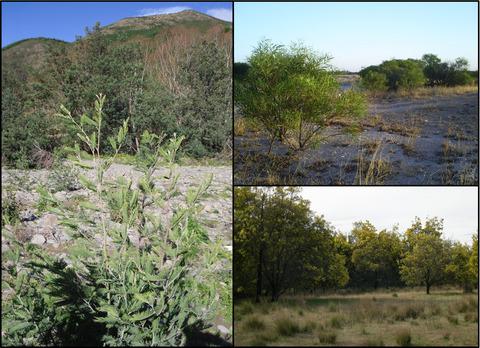当前位置:
X-MOL 学术
›
J. Appl. Ecol.
›
论文详情
Our official English website, www.x-mol.net, welcomes your
feedback! (Note: you will need to create a separate account there.)
Availability of soil mutualists may not limit non‐native Acacia invasion but could increase their impact on native soil communities
Journal of Applied Ecology ( IF 5.0 ) Pub Date : 2020-03-06 , DOI: 10.1111/1365-2664.13577 Elizabeth M. Wandrag 1, 2 , Christina Birnbaum 3 , Metha M. Klock 4 , Luke G. Barrett 5 , Peter H. Thrall 5
中文翻译:

土壤互惠生的可获得性可能不会限制非本地相思入侵,但可能会增加其对本地土壤群落的影响
更新日期:2020-03-06
Journal of Applied Ecology ( IF 5.0 ) Pub Date : 2020-03-06 , DOI: 10.1111/1365-2664.13577 Elizabeth M. Wandrag 1, 2 , Christina Birnbaum 3 , Metha M. Klock 4 , Luke G. Barrett 5 , Peter H. Thrall 5
Affiliation

|
- The availability of compatible mutualistic soil microbes could influence the invasion success of non‐native plant species. Specifically, there may be spatial variation in the distribution of compatible microbes, and species‐specific variation in plant host ability to associate with available microbes. Although either or both factors could promote or limit invasion, the scale over which most studies are conducted makes it difficult to examine these two possibilities simultaneously. However, this is critical to identifying a role of soil microbes in invasion.
- A series of recent research projects focused on interactions between Australian Acacia and nitrogen‐fixing bacteria (rhizobia) at multiple spatial scales, from the local to the inter‐continental, has allowed us to evaluate this question. Collectively, this research reveals that nodulation, performance and rhizobial community composition are all broadly similar across spatial scales and differentially invasive species.
- Synthesis and applications. We argue that current research provides convincing evidence that interactions with rhizobia do not determine invasion success in Acacia, but instead highlights key knowledge gaps that remain unfilled. Importantly, the ease with which non‐native Acacia species form mutualistic associations with rhizobia, regardless of invasive status, highlights the critical need to understand the impacts of all non‐native Acacia on native soil communities.
中文翻译:

土壤互惠生的可获得性可能不会限制非本地相思入侵,但可能会增加其对本地土壤群落的影响
- 相容的互惠土壤微生物的可用性可能会影响非本地植物物种的入侵成功。具体而言,相容性微生物的分布可能存在空间差异,而植物宿主与可用微生物相关联的能力存在物种特定的差异。尽管这两个因素中的一个或两个都可能促进或限制侵袭,但是大多数研究的规模使得难以同时检查这两种可能性。但是,这对于确定土壤微生物在入侵中的作用至关重要。
- 从本地到洲际,澳大利亚洋相思和固氮细菌(根瘤菌)在多个空间尺度上的相互作用的一系列最新研究项目使我们能够评估这个问题。总的来说,这项研究揭示了结瘤,性能和根瘤菌群落组成在空间尺度和不同入侵物种上都大体相似。
- 综合与应用。我们认为,当前的研究提供了令人信服的证据,证明与根瘤菌的相互作用并不能决定相思树的入侵成功与否,但可以凸显尚未填补的关键知识差距。重要的是,无论侵入状态如何,非本地相思树种与根瘤菌形成相互联系的难易程度凸显了理解所有非本地相思树对本地土壤群落的影响的迫切需求。









































 京公网安备 11010802027423号
京公网安备 11010802027423号